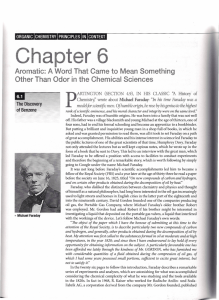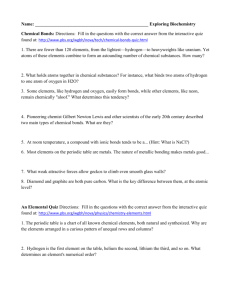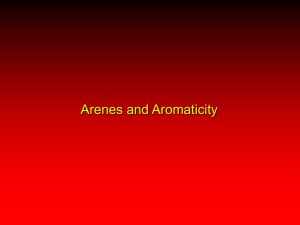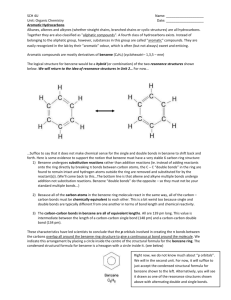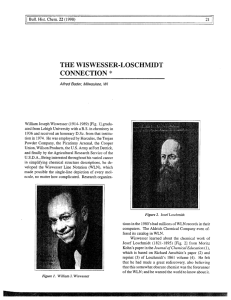KS5 Kebule 1
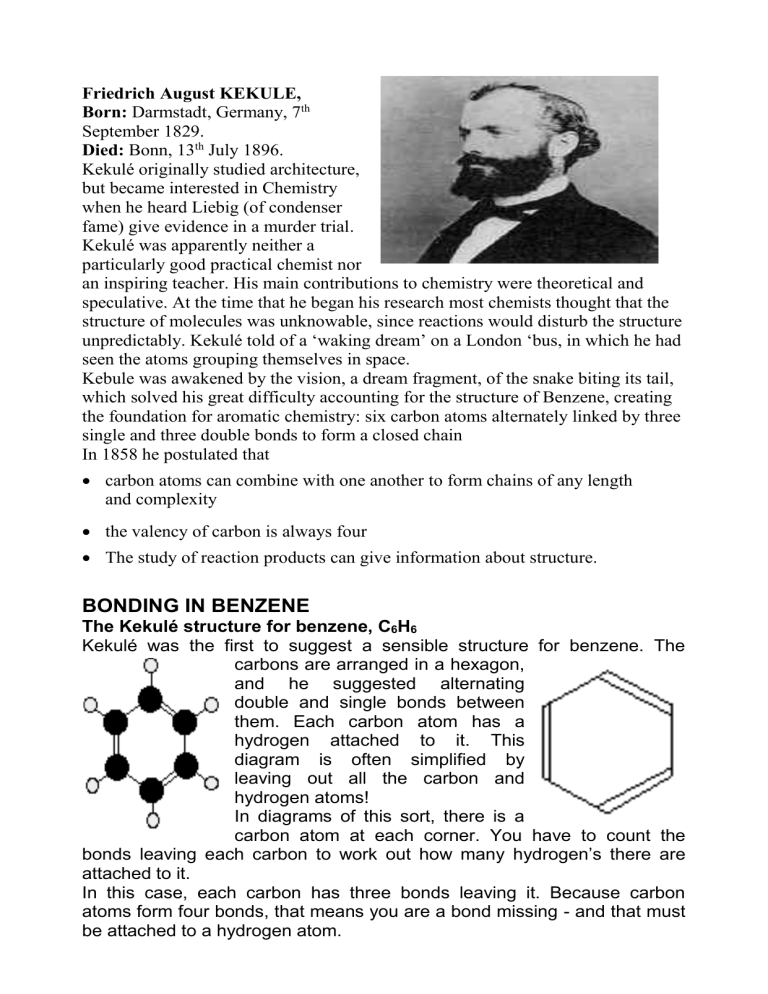
Friedrich August KEKULE,
Born: Darmstadt, Germany, 7 th
September 1829.
Died: Bonn, 13 th July 1896.
Kekulé originally studied architecture, but became interested in Chemistry when he heard Liebig (of condenser fame) give evidence in a murder trial.
Kekulé was apparently neither a particularly good practical chemist nor an inspiring teacher. His main contributions to chemistry were theoretical and speculative. At the time that he began his research most chemists thought that the structure of molecules was unknowable, since reactions would disturb the structure unpredictably. Kekulé told of a ‘waking dream’ on a London ‘bus, in which he had seen the atoms grouping themselves in space.
Kebule was awakened by the vision, a dream fragment, of the snake biting its tail, which solved his great difficulty accounting for the structure of Benzene, creating the foundation for aromatic chemistry: six carbon atoms alternately linked by three single and three double bonds to form a closed chain
In 1858 he postulated that
carbon atoms can combine with one another to form chains of any length and complexity
the valency of carbon is always four
The study of reaction products can give information about structure.
BONDING IN BENZENE
The Keku lé structure for benzene, C
6
H
6
Kekulé was the first to suggest a sensible structure for benzene. The carbons are arranged in a hexagon, and he suggested alternating double and single bonds between them. Each carbon atom has a hydrogen attached to it. This diagram is often simplified by leaving out all the carbon and hydrogen atoms!
In diagrams of this sort, there is a carbon atom at each corner. You have to count the bonds leaving each carbon to work out how many hydrogen’s there are attached to it.
In this case, each carbon has three bonds leaving it. Because carbon atoms form four bonds, that means you are a bond missing - and that must be attached to a hydrogen atom.
TASK – Using the experimental results and observations given below. Describe the limitations and problems with the Kebule structure. Suggest a structure for benzene and using previous knowledge of mechanism how benzene might take part in organic reactions
Experimental data
Organic reactions
Because of the three double bonds, you might expect benzene to have reacti ons like ethene - only more so!
Ethene undergoes addition reactions in which one of the two bonds joining the carbon atoms breaks, and the electrons are used to bond with additional atoms. Benzene rarely does this. Instead, it usually undergoes substitution reactions in which one of the hydrogen atoms is replaced by something new .
Shape and bond lengths
Benzene is a planar molecule (all the atoms lie in one plane), and that would also be true of the Kekulé structure.
The problem is that C-C single and double bonds are different lengths.
C-C 0.154 nm
C=C 0.134 nm
That would mean that the hexagon would be irregular if it had the Kekulé structure, with alternating shorter and longer sides. In real benzene all the bonds are exactly the same - intermediate in length between C-C and C=C at
0.139 nm. Real benzene is a perfectly regular hexagon.
Stability of benzene
Real benzene is a lot more stable than the Kekulé structure would give it credit for. Every time you do a thermochemistry calculation based on the Kekulé structure, you get an answer, which is wrong by about 150 kJ, mol -1 . This is most easily shown using enthalpy change of hydrogenation.
Hydrogenation is the addition of hydrogen to something. If, for example, you hydrogenate ethene you get ethane:
CH
2
=CH
2
+ H
2 =
CH
3
CH
3
In order to do a fair comparison with benzene (a ring structure) we're going to compare it with cyclohexene.
Cyclohexene, C
6
H
10
, is a ring of six carbon atoms containing just one C=C. The structures of cyclohexene and cyclohexane are usually simplified in the same way that the Kekulé structure for benzene is simplified - by leaving out all the carbons and hydrogen’s.
(Hint – Draw out cyclohexene with one double bond, then cyclohexa-1,3-diene etc)
In the cyclohexane case, for example, there is a carbon atom at each corner, and enough hydrogen’s to make the total bonds on each carbon atom up to four. The enthalpy change during this reaction is -120 kJ mol -1 . In other words, when 1 mole of cyclohexene reacts, 120 kJ of heat energy is evolved.
If the ring had two double bonds in it initially ( cyclohexa-1,3-diene ), exactly twice as many bonds would have to be broken and exactly twice as many made. In other words, you would expect the enthalpy change of hydrogenation of cyclohexa-1,3-diene to be exactly twice that of cyclohexene - that is, -240 kJ mol -1 . In fact, the enthalpy change is -
232 kJ mol -1 - which isn't far off what we are predicting.
Applying the same argument to the Kekulé structure for benzene (what might be called cyclohexa-1,3,5-triene ), you would expect an enthalpy change of -360 kJ mol -1 , because there are exactly three times as many bonds being broken and made as in the cyclohexene case. In fact what you get is -208 kJ mol -1 - not even within distance of the predicted value!



